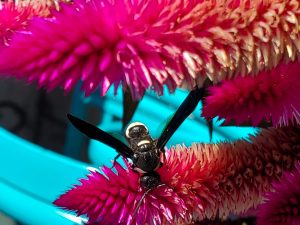ANNOUNCING SOFO’S NEW BACKYARD WATCH CITIZEN SCIENCE PROJECT
We are calling on all of our young environmentalists to observe and document nature awakening in your own backyards. We ask you to send us pictures of your findings with the date you discovered them, and your name and any notes you would like to include. We are happy to feature observations sent in by our fellow environmentalists, with details about the nature sightings they shared with us. Please send your photographs and notes to [email protected]. Stay safe and be on the look out for Nature news in your backyard!
 |
 |
Photos submitted by Dorothy Remaly
The Black Swallowtail can be found across the lower 48 states from the Rocky Mountains to the East Coast. The caterpillars eat members of the carrot family including dill, fennel, carrots, parsley, and Queen Ann’s Lace (wild carrot), which the adults identify by taste-scent receptors on their feet. This caterpillar’s parents survived the winter as chrysalises and is the first of two generations born each year in our area. The bold coloration of the caterpillar (and, later, the adult) warns potential predators that they taste bad and may cause the predator to be ill.

Photo submitted by Dorothy Remaly
The female Four-toothed Mason Wasp is a solitary wasp which uses mud to separate individual cells/rooms for her young to grow and metamorphose inside. She may house her young in wood borings, abandoned nests of mud dauber wasps, ground nesting bees, or carpenter bees, or dig her own burrow. They are an important beneficial insect as a pollinator and native caterpillar predator, hunting an assortment of leaf-rolling and cutworm moth caterpillars. Her sting can be used for defense but is more often used when hunting caterpillars to feed to her young. This individual likely over-wintered here as a pupa

Photo submitted by Jennifer Senft
The Northern Flicker is a ground feeding woodpecker that can be found year-round across the lower 48 states of the US from coast to coast. Instead of pecking out insects from trees, the Northern Flicker prefers to search the ground and peck out (or dig up) a variety of invertebrates including ants and larva, beetles and grubs, snails, and flies. During with winter they add a variety of fruits and berries (including poison ivy berries), seeds, and sometimes visit at suet feeders. When flying, the underwing of eastern flickers is a noticeable yellow while the underwing of western flickers is an orange-red. The male flickers have a noticeable ‘moustache’ (called a ‘malar’ by ornithologists) which is black in the eastern US and red in the western US.
